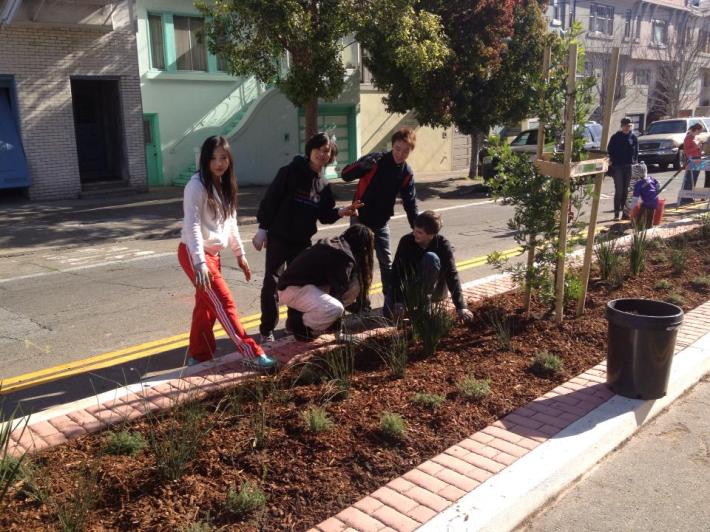Residents are enjoying a more livable outer Bryant Street since the city implemented a road diet last month, reducing four traffic lanes to two (plus left-turn bays at some intersections) between 23rd and Cesar Chavez Streets. Neighbors joined Friends of the Urban Forest on Sunday on the block between 26th Street and Cesar Chavez to add trees and plants to two new medians -- visual signals that drivers should slow down as they enter the neighborhood from the 101 freeway.

The project, part of a bigger slate of traffic calming improvements planned for the neighborhood, has made the intersection of Bryant and Cesar Chavez much safer for pedestrians, said Fran Taylor of CC Puede. "For me, the most important improvement has been the elimination of the double left-turn that used to feed traffic from southbound Bryant onto eastbound Cesar Chavez and the freeway ramp, making the pedestrian crossing on the east side of Chavez a death-defying experience," she said. "The median, especially now that it's landscaped, makes the street feel smaller and cozier."
In its 2010 Mission Streetscape Plan, the Planning Department noted that Bryant had "far more roadway space than is needed for the amount of traffic that uses the street," which led to "fast-moving traffic and neighborhood cut-throughs, and... a landscape that is dominated by asphalt."
To calm car traffic, planners removed traffic lanes, added medians, and re-arranged some on-street parking spaces to be perpendicular with the curb, narrowing what used to look like a wide-open roadway.
The plan also calls for more midblock sidewalk extensions (also known as chicanes) along Bryant, including a "landscaped plaza" between 25th and 26th, but those improvements are included in the long-term phase. And that's not set for implementation for ten or more years, due to the limited funds available for such projects.
Meanwhile, construction continues on nearby western Cesar Chavez, where two of the six traffic lanes on the dangerous motorway will be removed, making way for a wide planted median, bike lanes, and sidewalk corner bulb-outs. Completion for that project, previously scheduled for this summer, has been pushed back to the end of the year, according to the Department of Public Works website.
Taylor said that since the lanes were removed from Bryant, it has seen some car congestion during the evening rush hour, "sometimes obstructing the Bryant crosswalks at 26th Street, so it's a trade-off." Experience suggests the back-ups won't be permanent. As drivers adjust to street changes, traffic patterns evolve, and initial increases in congestion don't last. And, as Taylor noted, the back-ups only occur during a short time of the day, "whereas the noxious double left turn was always a danger."









